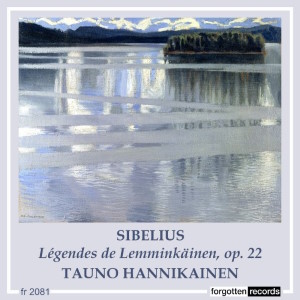
Jean Sibelius (1865-1957)
Four Lemminkäinen Legends, Opus 22 (original versions 1895)
USSR Radio Symphony Orchestra/Tauno Hannikainen
rec. 1958
Forgotten Records FR2081 [47]
Obviously there isn’t room in the typical concert repertoire – already half-filled with over-familiar pieces – for all our personal, off-the-beaten-track favourites. Nevertheless, I hope the widespread conservatism will never deter music-lovers from attention-seeking on behalf of such composers as Busoni, Myaskovsky, K. A. Hartmann and Gerhard, to randomly name a few. So – I make a special plea for the Lemminkäinen Legends, which deserve more than a rare performance. This is relatively early Sibelius, but richly rewarding.
The Russian orchestra on this CD – and on the other Hannikainen reissue of the Fourth Symphony – is superb, while to my mind the conductor himself is more impressive in this suite of legends than in the symphony, where too often a shortage of tension bothered me. Even in Lemminkäinen and the Maidens of the Island I occasionally feel a degree of literalness – an immediacy, where ideally there would be more atmosphere. Also, allowing for the age of the recording, the dynamic range is limited – a problem which may be related to the previous point. However, in this case these problems detract less than in the symphony. Indeed these performances are generally powerful and involving. The opening legend is a gem, distinguished here by playing which is wonderfully alive, with especially characterful woodwind. Hannikainen conducts with total conviction.
The score of the second legend, The Swan of Tuonela, is inscribed with lines from Runo XIV of the Kalevala: Tuonela, the land of death, the hell of Finnish mythology, is surrounded by a large river with black waters and a rapid current, on which the Swan of Tuonela floats majestically, singing.
The tempo marking of Andante molto sostenuto is observed here, where many conductors are more indulgent. It is worth stressing, as a generalisation, that it is very possible to be expressive without taking a slower tempo. However, with the Kalevala quote in mind, I wish the mood could be even darker (- in any case, one doesn’t need to have read those words to be conscious of the deeply sombre character of this piece), while quieter dynamics are not always followed. Again I am aware of a certain literalness, a short-changing of the essential poetry. The solo cor anglais is eloquent and there is much to admire in this performance, so I hope my remarks do not seem too carping.
Lemminkäinen in Tuonela, originally placed second, is an evocation of the hero’s mission to kill the Swan of Tuonela, his subsequent ambush and death. Much of the Kalevala is brutal and this episode is typical – Lemminkäinen’s body is cut into pieces and thrown in the river. Although the least compelling of the four, this legend is aptly dramatic and full of contrasts which are well realised in this performance.
In Lemminkäinen’s Homecoming (marked Allegro con fuoco) Hannikainen maintains tension and excitement, concluding a fine performance and an essential purchase for all Sibelius aficionados. Returning to two other recordings – those by Neemi Jarvi and his son Paavo, I find myself favourably revising my feelings about the Hannikainen. However, best of all is the Ormandy reissued on Pristine. He was a passionate Sibelius interpreter and, incidentally, a much better conductor (if variable) than he is now given credit for.
Sometimes solo woodwind instrument are unnaturally highlighted, but the sound is generally very good. One would never guess that the recording was made in 1958 in Moscow. Like the other Forgotten Records release of the Fourth Symphony, Karelia and Tapiola, this CD has absolutely no booklet, but simply a single folded-over sheet. Another quibble is the very short duration of this disc. Couldn’t another Hannikainen recording have been added?
Philip Borg-Wheeler
| Availability |  |


















